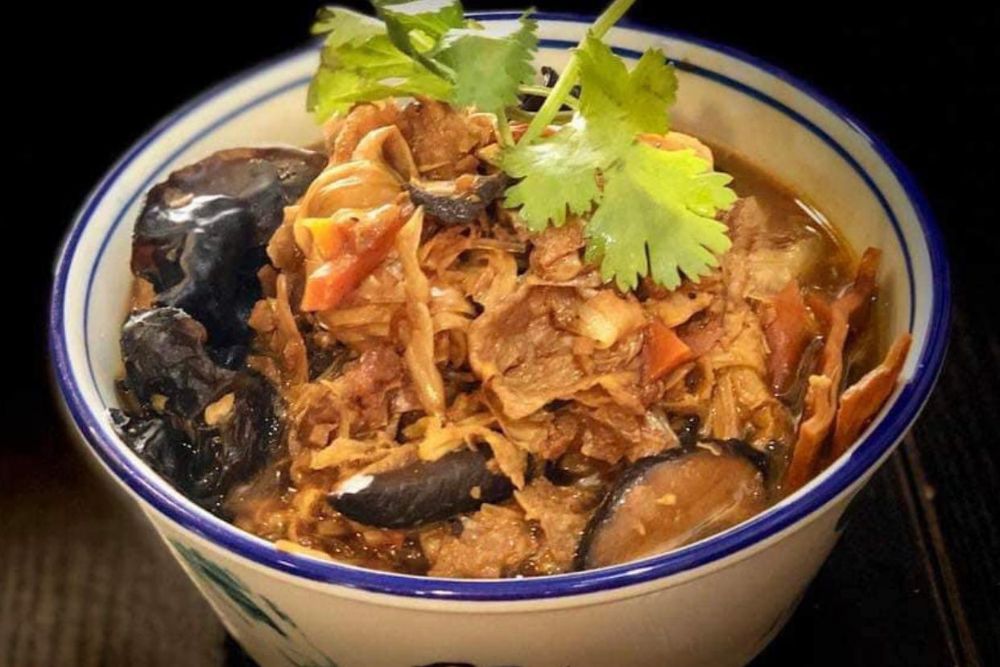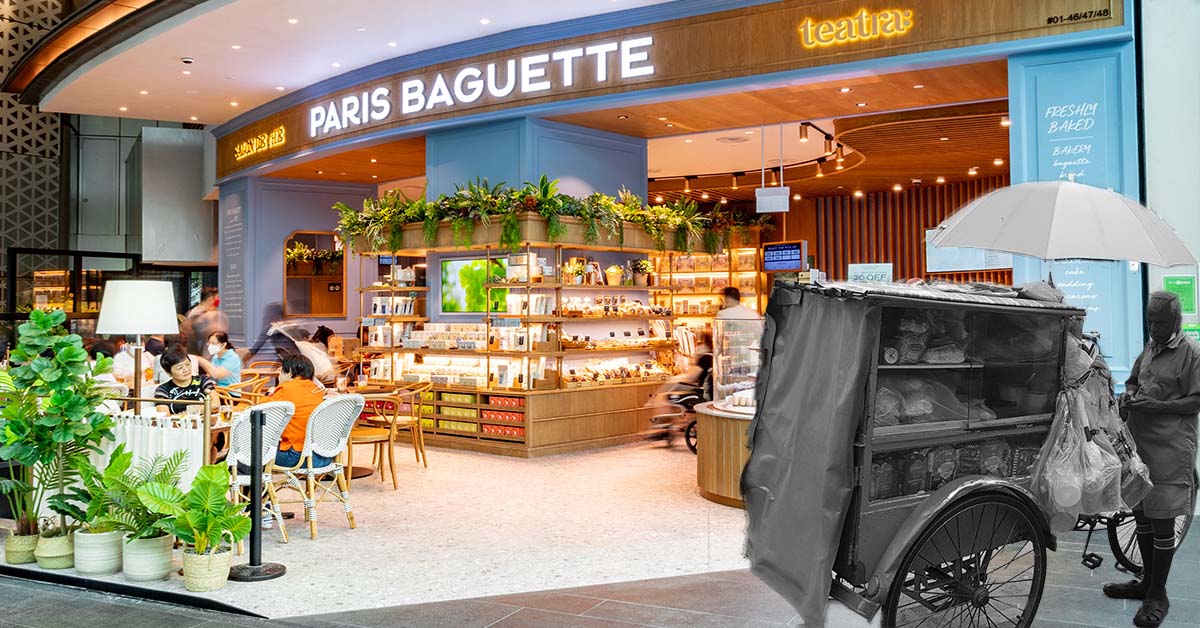
“My family has three different versions of Chap Chye,” scoffs my husband who has Cantonese and Foo Chow parentage, “but none of them is like yours!”.
Being a Peranakan, with only one version of Chap Chye, I was a little more than miffed by his assertion.
After all, “Chap Chye” or “mixed vegetables” is the most important vegetable dish in Peranakan cuisine. Nyonya Chap Chye is a braised assorted vegetable stew of cabbage, carrot, beancurd skins, wood ear fungus and mung bean vermicelli. It must be accompanied of course, by a liberal dollop of sambal belacan.
On prayer days, this same dish will be elevated to “Chap Chye Sembayang” or “Chap Chye Chin”. “Sembayang” means prayer and “Chin” refers to “Chin Lang”, which in this context are our dearly beloved departed ancestors. Additional ingredients like dried lily buds (or golden needles) and rehydrated dried mushrooms are added to Chap Chye to make Chap Chye Chin.
The ends of the lily buds would need to be tied together before being added into the Chap Chye Chin. This will prevent fraying during the long stewing process, but in spiritual terms also symbolises the departed souls’ ability to reunite and to continually and continuously maintain family harmony over generations.
Advertisement
This same epithet is also found in another important Peranakan prayer dish: the “Babi Chin”. In this case, since “babi” means pork, it is the meat iteration on prayer day, and much relished by non-vegetarians.
Both Chap Chye Chin and Babi Chin are quintessentially Chinese Peranakan dishes offered on the family altar. Preserved soybean paste imported from China is the main braising ingredient for both dishes, which is also why these dishes are darker (and more sombre) in colour. Hence, in the past, it was not served during celebratory occasions and often served after funerals.
Nowadays, like blue pea rice and nyonya noodles, Chap Chye Chin is served at any occasion, including birthdays.
Another near-extinct Peranakan version of Chap Chye is “Chap Chye Titek”. As with many Nyonya dishes, Chap Chye Titek has a wet spice or ‘rempah’ base. However, unusually, there is no need to sauté the rempah low and slow until the oil seeps out from the paste.
The definition of Chap Chye
So what exactly is “Chap Chye”? It can be simply translated to “mixed vegetables”, but there are so many variations available in Singapore. On one end of the scale, it can be made with local vegetables cheaply and easily available.
On the other end of the scale, “Lo Han Chye” is a luxurious vegetarian showpiece dish named after the 18 Arhats or disciples of Buddha, and consists of premium ingredients such as the best of dried and fresh mushrooms, gingko nuts and soybean products. These expensive vegetables would be simmered slowly into a delicious stew.
As this dish is often eaten by Buddhist vegetarians, garlic is not included in this version as it is considered a stimulant.
The familiarity of Chap Chye to Singaporeans even led our Prime Minister Goh Chok Tong in 1999 who gave us a stern warning not to slip into “Chap Chye Mandarin”, when spoken Mandarin turns into a mish mash of dialect and English interspersed into Mandarin.
In Singapore, “Chap Chye Png”, or “economy rice” is ubiquitous in all food centres and coffeeshops. Diners can choose from an array of pre-cooked meat and/or vegetable dishes to eaten with rice (or porridge). Chap Chye is usually offered as one of the dishes as well.
Chap Chye in the region
Cap Cai, which originated as a dish from Hokkien migrants, is a staple in Indonesian kitchens and served everywhere from the humblest warung to high-end restaurants serving Asian food.
They generally fall into two categories: With gravy – Cap Cay Kuah (gravy), Siram (literally, flushed or watered), or Basah (wet). As a stir-fry, it would be known as Cap Cay Kering, or Cap Cay Goreng.
In Philippines, Chop Suey (also spelt as Chap Suey) is very similar to Chap Chye. But are they the same?
The Chinese words for these two dishes are different – Chap Chye is written as “杂菜” while Chop Suey is “杂碎”.
Chop Suey has the connotation of a dish thrown together with whatever ingredients are available, even bean sprouts and meat, which are not usually included in Chap Chye. Some accounts trace the original Chop Suey to a dish of sliced offal, such as heart, tripe, liver and gizzards of cows and sheep.
As with the recipes appended below, there are distinct differences among Chap Chye served by the various Chinese dialects and Peranakans.
One would be the aromatic base or ‘sofrito’ with which to sauté the vegetables and meats, and the other, the addition of signature ingredients which mark the different versions of Chap Chye apart.
Chap Chye is one heritage dish that spans Southeast Asia and is easily made vegetarian. With its strong roots in the Chinese diaspora, there are many variations by dialect groups and countries, as well as well-loved family heirloom recipes that have been passed down by generations.
Differences between Asian Chap Chye

Aromatic Base
-
Hainanese/Hokkien/Peranakan:
Pounded or chopped garlic and brown soybeans or soybean paste -
Cantonese:
Fermented bean curd -
Foochow:
Red wine lees -
Filipino:
Chopped garlic and red onion with a dash of soy sauce -
Indonesian:
Chopped garlic with a dash of oyster sauce
Signature Ingredients
-
Hainanese:
Dried fried pork skin or rind and dried cuttlefish -
Peranakan:
Dried lily buds, mung bean vermicelli ("tang hoon"), wood ears -
Hokkien:
Dried shrimp -
Cantonese:
Black moss (commonly known as "fatt choy") -
Filipino:
Quail eggs, liver, gizzard -
Indonesian:
Assorted "bakso" or meatballs cut in half, chicken strips
Recipes
Chap Chye, which basically means ‘mixed vegetables’, can be as simple as an assorted vegetables stir-fry. Even within the same dialect groups or countries, choices of ingredients may differ greatly. However, the general methods of cooking remain the same.
- Nyonya Chap Chye (serves 8)
Ingredients
- 1 kg prawns (rinsed well, deveined and shelled, reserving the prawn heads and shells)
- 400g belly pork (boiled in enough water to cover, reserving stock), cut the belly pork into 1 cm strips
- 15 cloves of garlic (peeled and pounded)
- 2 cloves of garlic (crushed)
- 2 Tablespoons brown soya bean paste (taucheo)
- 30g lily buds (soaked in water to rehydrate, tying the ends of pairs together)
- 10 thick flower mushrooms (soaked in water to rehydrate, and cut into thick strips)
- 30g wood ear mushrooms (soaked in water to rehydrate, remove the hard centre, and tear into sections)
- 20g fatt choy (black moss), soak and drain
- 50g dried light coloured bean curd sticks, soaked to soften and snipped into 5 cm strips
- 150g dried wide (sweet) bean curd strips, soaked to soften and snipped into 2cm strips
- 1 carrot (peeled, and cut into thin rounds)
- 1 head of cabbage (rinsed and torn into 4 cm squares)
- 30g glass or mung bean vermicelli (soaked and drained)
- 20 shelled gingko nuts (optional)
- 1 tablespoon light soya sauce
Method
- To make prawn stock, add 3 tablespoons of oil to a large work, and when hot, the crushed garlic.
- Add in all the prawn shells and fry till shells are red and crispy. Add 1 tsp of salt and enough water to cover prawn shells.
- Simmer the prawn shells for 15 minutes, topping up the water if necessary.
- Drain, keeping stock and discarding the shells.
- Using a paper towel, dry the sweet bean curd strips.
- Rinse and dry the wok, and when hot, add in 3 tablespoons of oil. When the oil is heated, slide in the bean curd strips. Lift up and drain when curled at the ends but do not scorch.
- In the same wok, add in another tablespoon of oil if needed together with the pounded garlic, and when fragrant, add in the taucheo, stirring well.
- Add in prawns and sauté until just pink.
- Mix in belly pork strips, mushrooms, lily buds, fatt choy, carrot, belly pork stock and half the prawn stock. Simmer till the liquid is absorbed.
- Add in the rest of the prawn stock with the light soya sauce together with the cabbage, all the soybean products, gingko nuts and vermicelli and simmer till the cabbage is cooked.
- Add salt to taste, bearing in mind that it may taste saltier, as the flavours will deepen with keeping.
- Cap Cai - Indonesian (serves 4)

Ingredients
- 1 carrot, peeled and sliced thinly
- 30g mustard greens, bok choy or chye sim, cut into finger lengths
- 30g cabbage, cut into 3 cm squares
- 5 button mushrooms, sliced thickly
- 1 stalk of leeks, sliced on a slant
- 100g chicken fillet, sliced thickly
- A few meat or fish balls, halved
- ½ red onion, peeled and sliced
- 2 cloves garlic, peeled and crushed
- 3 tablespoons oil
- 1 tablespoon light soy or fish sauce
- Salt and pepper to taste
Method
- Heat up the oil and sauté garlic, onion and leeks till fragrant.
- Add in the chicken, meatballs and carrot, stirring constantly until the chicken turns opaque.
- Add in the rest of the vegetables and toss, adding the seasoning ingredients and a few tablespoons of water, if desired.
- Once cooked, serve immediately.
Common variations
-
Vegetables:
broccoli, cauliflower florets, carrots, french beans -
Meats:
peeled whole prawns, slices of fishcake, slices of pork or beef - To make a thicker gravy, stir in a teaspoon of cornflour at the end of the cooking time
- Filipino Chop Suey
Very similar to the above, with the addition of quails’ eggs to the vegetables.
- Cantonese Style Chap Chye
Use fermented white bean curd (foo yee) in place of the brown bean curd, omitting the prawn stock and belly pork strips. Lily buds and soybean products are subject to preference. Fried beancurd puffs are added at the end. For non-vegetarian Chap Chye, roast pork is often added.
- Foochow Style Chap Chye
Similar to Cantonese style Chap Chye, replacing the fermented bean curd with a few tablespoons red wine lees and if preferred, adding more fermented red wine to braise the vegetables.
- Hainanese Chap Chye
Instead of prawn stock, chicken or pork stock is used. Cuttlefish and pork skin cut into strips are added together with the vegetables.
- Lo Han Chye
Since this is a vegetarian dish, prawn and meat are to be omitted. The cooking method is otherwise similar to Nyonya Chap Chye. Lotus root, sliced into thin rounds, slices of bamboo shoots, water chestnuts, canned button or straw mushrooms and mock abalone, or other vegetarian gluten “meats” are often added to Lo Han Chye.







